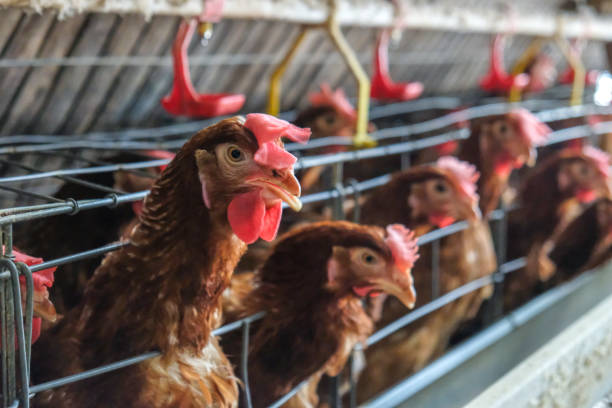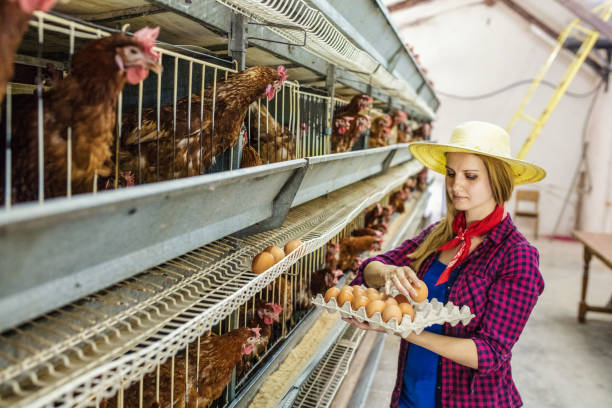Automating Your 10,000 Broiler Chicken Farm: A Complete Guide
Automating Your 10,000 Broiler Chicken Farm: A Complete Guide
So, you’re thinking about leveling up your broiler operation and automating your 10,000-bird farm? Smart move! In today’s increasingly competitive market, automation isn’t just a fancy add-on; it’s often the key to boosting efficiency, reducing labor costs, and ultimately, maximizing your profits. But where do you even begin? This guide will walk you through everything you need to know, from the upfront costs to long-term benefits, and help you make informed decisions for your specific needs.

Why Automate a Broiler Farm? The Obvious (and Not-So-Obvious) Benefits
Let’s be honest, running a broiler farm is hard work. It’s a 24/7 operation that demands constant attention. Automation can alleviate many of these burdens, leading to a wealth of advantages:
Reduced Labor Costs: This is the big one. Automated systems handle many routine tasks, significantly cutting down on the number of employees you need. Imagine freeing up your team to focus on more strategic tasks like flock health management and market analysis.
Increased Efficiency: Automated feeding, watering, and climate control systems deliver consistent, precise inputs, ensuring optimal growing conditions for your birds. This translates directly into faster growth rates and improved feed conversion ratios (FCR).

Improved Bird Welfare: Consistent environmental conditions and readily available feed and water mean happier, healthier birds. This translates to fewer health problems, lower mortality rates, and better overall product quality.
Enhanced Biosecurity: Automation can minimize human contact with the birds, reducing the risk of disease transmission. This is especially important in today’s world, where biosecurity is paramount for protecting your investment.
Data-Driven Insights: Modern automated systems come equipped with sensors and data logging capabilities. This allows you to track key performance indicators (KPIs) like temperature, humidity, feed consumption, and bird weight in real-time. Armed with this data, you can make informed decisions to optimize your operation and identify potential problems early on.
Scalability: Once you’ve automated your 10,000-bird farm, scaling up to a larger operation becomes much easier. The systems and knowledge you’ve gained can be readily applied to manage a larger flock.
Better Consistency: Automated systems perform tasks uniformly, day in and day out. This consistency leads to predictable growth rates and product quality, making it easier to meet market demands.
Key Areas for Automation in Your Broiler Farm
Now, let’s dive into the specific areas where you can introduce automation to your broiler farm.
Feeding Systems:
Automated Feeders: These systems deliver a precise amount of feed to each bird, ensuring uniform growth and minimizing feed waste. Options include chain feeders, trough feeders, and spiral feeders. Choose a system that is appropriate for the age and size of your broilers.
Feed Silos and Conveyors: Automate the process of storing and transporting feed from the silo to the feeders. This eliminates manual labor and ensures a consistent supply of feed to your birds. Look for silos with integrated weighing systems to track feed consumption accurately.
Watering Systems:
Nipple Drinkers: Nipple drinkers are a hygienic and efficient way to provide water to your broilers. They minimize water spillage, reduce the risk of contamination, and ensure that each bird has access to fresh, clean water.
Automatic Water Proportioners: These devices automatically mix medication or supplements into the water supply, ensuring that all birds receive the correct dosage.
Climate Control Systems:
Ventilation Systems: Proper ventilation is crucial for maintaining optimal air quality and temperature inside the broiler house. Automated ventilation systems use fans and inlets to circulate air, remove excess moisture and ammonia, and prevent heat stress. Consider tunnel ventilation for larger houses and natural ventilation for smaller, well-ventilated structures.
Heating Systems: Broilers require a consistent temperature, especially during their early stages of growth. Automated heating systems, such as gas heaters, radiant heaters, and floor heating, can maintain the desired temperature, regardless of the weather conditions.
Cooling Systems: In hot climates, cooling systems are essential for preventing heat stress and mortality. Options include evaporative cooling pads, fogging systems, and high-pressure misting systems. Combine these systems with proper ventilation for maximum effectiveness.
Environmental Controllers: These sophisticated devices monitor and control all aspects of the indoor environment, including temperature, humidity, ventilation, and lighting. They automatically adjust the settings of the various systems to maintain optimal conditions for broiler growth.
Lighting Systems:
LED Lighting: LED lights are energy-efficient and long-lasting, making them a cost-effective choice for broiler houses. They can be programmed to provide the optimal light intensity and duration for broiler growth and behavior.
Automatic Light Controllers: These devices automatically control the lighting schedule, ensuring that the birds receive the appropriate amount of light and darkness each day.
Manure Removal Systems:
Automatic Scrapers: These systems automatically scrape the manure from the floor of the broiler house, reducing ammonia levels and improving air quality.
Conveyor Belts: Conveyor belts can be used to transport manure from the house to a storage area or composting facility.
Egg Collection (If applicable): While primarily for laying hens, if you’re managing breeding stock for broiler production, automated egg collection systems are vital. These systems gently collect eggs, minimizing damage and reducing labor.
Calculating the Costs: A Realistic Budget
Automating a broiler farm is a significant investment. The exact cost will depend on the size of your operation, the level of automation you choose, and the specific equipment you select. However, here’s a rough estimate of the costs involved in automating a 10,000-bird broiler farm:
Feeding System: \$5,000 – \$15,000
Watering System: \$2,000 – \$5,000
Climate Control System: \$10,000 – \$30,000 (This can vary widely depending on your climate and the complexity of the system)
Lighting System: \$1,000 – \$3,000
Manure Removal System: \$3,000 – \$10,000
Environmental Controller: \$2,000 – \$5,000
Installation and Labor: \$5,000 – \$15,000 (This can also vary depending on the complexity of the installation and local labor rates)
Total Estimated Cost: \$28,000 – \$83,000
Keep in mind that these are just estimates. It’s essential to get quotes from multiple suppliers and factor in any additional costs, such as building modifications or electrical upgrades.
Choosing the Right Equipment Supplier: Key Considerations
Selecting the right equipment supplier is crucial for the success of your automation project. Here are some key factors to consider:
Experience and Reputation: Choose a supplier with a proven track record in the poultry industry. Look for companies with positive customer reviews and a reputation for providing high-quality equipment and reliable service.
Product Quality: Ensure that the equipment is made from durable materials and is designed to withstand the harsh conditions of a broiler house environment.
Technical Support: Choose a supplier that offers comprehensive technical support, including installation assistance, training, and ongoing maintenance services.
Warranty: Make sure the equipment comes with a warranty that covers defects in materials and workmanship.
Price: While price is important, don’t sacrifice quality for cost. Choose a supplier that offers a competitive price without compromising on the quality of the equipment or the level of service.
Customization: Can the supplier tailor their solutions to your unique farm layout and specific needs? This is particularly important if you have an existing structure that you are retrofitting.
After-Sales Service: What happens when something breaks down? A reliable supplier will have a readily available parts inventory and a responsive service team.
Installation and Training: Getting Your System Up and Running

Once you’ve chosen your equipment and supplier, the next step is installation. It’s highly recommended to have the equipment installed by qualified technicians to ensure that it’s properly set up and functioning correctly. Your supplier should provide training on how to operate and maintain the equipment. Make sure to take advantage of this training to get the most out of your investment.
Maintenance and Troubleshooting: Keeping Your System Running Smoothly
Like any mechanical system, automated broiler farm equipment requires regular maintenance to keep it running smoothly. Develop a maintenance schedule that includes tasks such as cleaning feeders and drinkers, lubricating moving parts, and inspecting electrical connections. Learn basic troubleshooting techniques so you can quickly identify and resolve minor problems.
Long-Term ROI: Is Automation Worth the Investment?
While the initial investment in automation may seem daunting, the long-term return on investment (ROI) can be significant. By reducing labor costs, increasing efficiency, improving bird welfare, and enhancing biosecurity, automation can help you boost your profits and make your broiler farm more sustainable. Before making a decision, carefully analyze your current operating costs and project the potential savings and increased revenue that automation can bring. Consider factors like:
Feed Conversion Ratio (FCR) improvements: How much will automation improve your FCR?
Mortality Rate Reduction: Can you expect to see a decrease in bird mortality?
Labor Cost Savings: How many employees can you potentially reduce or re-allocate?
Growth Rate Improvements: Will automation lead to faster growth and earlier marketability?
By carefully evaluating these factors, you can get a clear picture of the potential ROI of automating your broiler farm.
Final Thoughts: Embrace the Future of Broiler Farming
Automating your 10,000-broiler chicken farm is a significant undertaking. It requires careful planning, a substantial investment, and a commitment to learning new technologies. However, the potential benefits are undeniable. By embracing automation, you can improve efficiency, reduce costs, enhance bird welfare, and ultimately, create a more profitable and sustainable broiler operation. Don’t be afraid to take the leap and join the growing number of poultry farmers who are leveraging technology to shape the future of the industry! Good luck!





